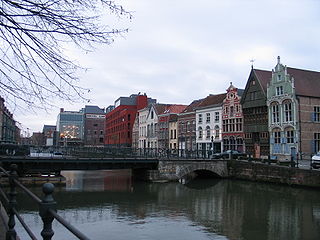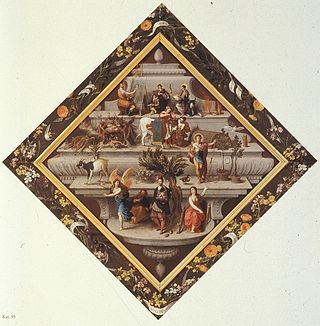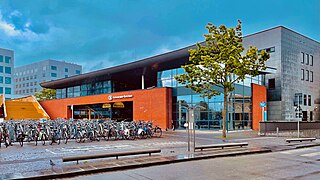
Sint-Niklaas is a Belgian city and municipality located in the Flemish province of East Flanders. The municipality comprises the city of Sint-Niklaas proper and the towns of Belsele, Nieuwkerken-Waas, and Sinaai.

Mechelen is a city and municipality in the province of Antwerp in the Flemish Region of Belgium. The municipality comprises the city of Mechelen proper, some quarters at its outskirts, the hamlets of Nekkerspoel (adjacent) and Battel, as well as the villages of Walem, Heffen, Leest, Hombeek, and Muizen. The Dyle flows through the city, hence it is often referred to as the Dijlestad.
Articles related to Belgium include:
Michiel Coxie the Elder, Michiel Coxcie the Elder or Michiel van Coxcie, Latinised name Coxius, was a Flemish painter of altarpieces and portraits, a draughtsman and a designer of stained-glass windows, tapestries and prints. He worked for patrons in the principal cities of Flanders. He became the court painter to successively Emperor Charles V and King Philip II of Spain.

The Dyle is a river in central Belgium, left tributary of the Rupel. It is 86 kilometres (53 mi) long. It flows through the Belgian provinces of Walloon Brabant, Flemish Brabant and Antwerp. Its source is in Houtain-le-Val, near Nivelles in Walloon Brabant.

The Flemish Diamond is the Flemish reference to a network of four metropolitan areas in Belgium, three of which are in the central provinces of Flanders, together with the Brussels Capital Region. It consists of four agglomerations which form the four corners of an abstract diamond shape: Brussels, Ghent, Antwerp and Leuven. Over 5 million people live in this area, with a population density of about 600 per km2 in 2002.

Antwerpen-Centraal railway station, officially Antwerpen-Centraal, is the main railway station in Antwerp, Belgium. The station is operated by the National Railway Company of Belgium (NMBS/SNCB).
Science and technology in Flanders, being the Flemish Community and more specifically the northern region of Belgium (Europe), is well developed with the presence of several universities and research institutes. These are strongly spread over all Flemish cities, from Kortrijk and Bruges in the Western side, over Ghent as a major university center alongside Antwerp, Brussels and Leuven to Hasselt and Diepenbeek in the Eastern side.

The Diocese of Antwerp is a Latin Church ecclesiastical territory or diocese of the Catholic Church in Belgium. The diocese was restored in 1961. It is a suffragan in the ecclesiastical province of the metropolitan Archdiocese of Mechelen-Brussels. Its cathedra is found within the Cathedral of Our Lady.

Renaat Braem was a leading Belgian architect and urban planner in the latter half of the twentieth century.

The Violieren was a chamber of rhetoric that dates back to the 15th century in Antwerp, when it was a social drama society with close links to the Guild of Saint Luke. It was one of three drama guilds in the city, the other two being the Goudbloem and the Olyftack. In 1660 the Violieren merged with former rival Olyftack, and in 1762 the society was dissolved altogether.

Antwerpen-Berchem is a railway station in the south of the city of Antwerp, Antwerp, Belgium. The station opened on 1 March 1865 and currently serves railway lines 25, 27, 27A and 59.

Mechelen railway station, officially Mechelen, is a railway station in Mechelen, Antwerp, Belgium. The station opened on 5 May 1835 on railway lines 25, 27 and 53. Train services are operated by the National Railway Company of Belgium (NMBS/SNCB).
The 2014–15 season of the Belgian Second Division began on 1 August 2014 and ended on 26 April 2015.
Henry Jaye was an English Catholic exile in the Southern Netherlands. He became printer to the city of Mechelen.

De Olijftak, or in full Gulde van den Heyligen Geest die men noempt den Olijftak was a chamber of rhetoric that dates back to the early 16th century in Antwerp, when it was a social drama society drawing its membership primarily from merchants and tradesmen. In 1660 it merged with its former rival the Violieren, and in 1762 the society was dissolved altogether.
The Goudbloem (marigold) was a chamber of rhetoric, a society to promote poetry and drama, that dated back to the 15th century in Antwerp. It was one of three drama guilds in the city, the other two being the Violieren and the Olyftack. It ceased to exist around 1654. The Violieren and Olyftack merged in 1660, and survived until 1762.
Hendrik Faydherbe or Henri Fayd'herbe (1574–1629) was a Flemish sculptor and gilder, and poet, who lived and worked in Mechelen, in the Southern Netherlands.

Landjuweel is the highest award for an amateur theatrical troupe to have received in Belgium. It has its historical origin in the contests among the Chamber of rhetoric of different cities of the Low Countries.
The 2022–23 Belgian Cup, called the Croky Cup for sponsorship reasons, is the 68th season of Belgium's annual football cup competition. The competition will begin on 24 July 2022 and will end with the final on 30 April 2023. The winners of the competition will qualify for the 2023–24 UEFA Europa League play-off round.












